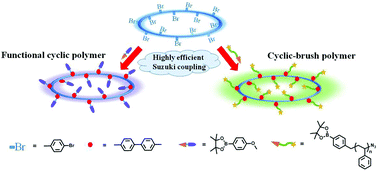The Suzuki coupling reaction as a post-polymerization modification: a promising protocol for construction of cyclic-brush and more complex polymers†
Abstract
Cyclic poly(4-bromostyrene) (c-PBrS), synthesized via a combination of atom transfer radical polymerization (ATRP) and copper(I)-catalyzed azide-alkyne cycloaddition (CuAAC), was employed as a universal cyclic precursor to prepare cyclic-brush polymers by the Suzuki coupling reaction. Cyclic functional poly[(4-methoxyphenyl)styrene] and cyclic-brush polystyrene have been achieved by the Suzuki coupling reaction as a post-modification, endowing excellent modification efficiency (∼100%), i.e., all the repeating units have been completely transformed into target ones. The obtained polymer structures were carefully characterized by NMR, GPC and MALDI-TOF mass spectra. This study undoubtedly offers a highly efficient and promising post-modification protocol to prepare cyclic-brush polymers or other more complex ones, the preparation of which was previously highly challenging.


 Please wait while we load your content...
Please wait while we load your content...